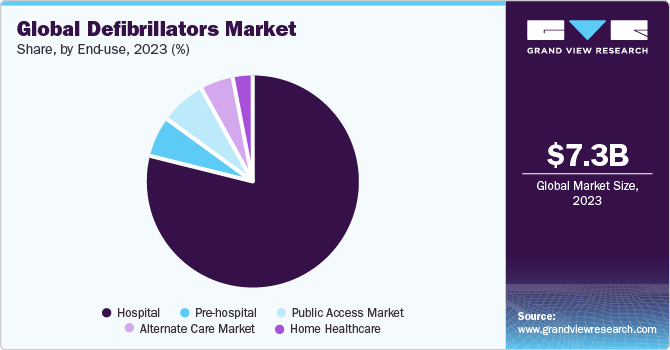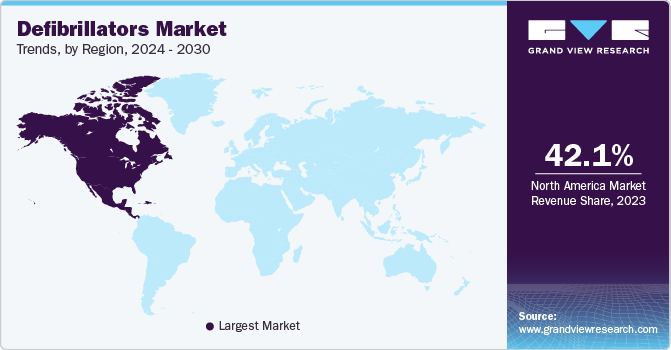- Home
- »
- Medical Devices
- »
-
Defibrillators Market Size, Share And Growth Report, 2030GVR Report cover
![Defibrillators Market Size, Share & Trends Report]()
Defibrillators Market Size, Share & Trends Analysis Report By Product (EDs, ICDs), By End-use (Hospital, Public Access Market, Alternate Care Market), By Region (North America, Asia Pacific), And Segment Forecasts, 2024 - 2030
- Report ID: 978-1-68038-368-3
- Number of Report Pages: 150
- Format: PDF, Horizon Databook
- Historical Range: 2018 - 2022
- Forecast Period: 2024 - 2030
- Industry: Healthcare
Defibrillators Market Size & Trends
The global defibrillators market size was estimated at USD 7.32 billion in 2023 and is expected to grow at a compound annual growth rate (CAGR) of 8.1% from 2024 to 2030. Increasing product development activities, rising incidence of sudden cardiac arrest, growing awareness among the general public, and supportive initiatives by governments & healthcare organizations are some of the key factors fueling industry growth. In May 2021, Rapid Response Revival Research Ltd.-an Australian company-received a CE mark for its CellAED, the world’s first personal automated external defibrillator (AED) for home use. This supported the company’s growth strategy.

The COVID-19 pandemic adversely impacted the industry, particularly the International Classification of Diseases (ICDs) market, with dampened demand and sales during 2020. The sales improved as the hospitals resumed elective surgeries. However, the progression of COVID-19 in several key markets continued to create uncertainty during the year. Abbott, for instance, reported improvement in its hospital-based businesses during Q2 and Q3 2020. However, the improving trends flattened or were negatively impacted during Q4 2020 due to a sudden increase in COVID-19 cases and hospitalizations in many countries. Nihon Kohden, on the other hand, reported strong sales growth of defibrillators in 2020, despite inhibited sales activity due to the pandemic.
Increasing geriatric population globally and technological advancements are other key factors that are projected to significantly impact market growth. The older population, particularly those aged between 65 years and above, is more vulnerable to chronic diseases, such as cardiovascular diseases (CVDs), which often require the placement of defibrillators to restore a normal heart rhythm by delivering an electric shock to the heart. For instance, in November 2022, the article "Senior Population Statistics: A Portrait of Aging Americans" reported that around 54.1 million (16.3%) individuals in the U.S. are aged 65 years or above. Thus, the growing geriatric population contributes to the increasing product demand.
Market Dynamics
The increasing prevalence of CVDs, specifically the significant contribution of sudden cardiac arrest to cardiovascular-related deaths, is a major factor propelling advancements in the market. For instance, as of January 2022, the American Heart Association (AHA) reported in their "Heart Disease and Stroke Statistics - 2022 Update" that CVD was responsible for roughly 19.0 million global fatalities. Furthermore, in July 2022, according to the Government of Canada, approximately 2.6 million (or 1 in 12) Canadian adults aged 20 years and over were diagnosed with heart disease.
Defibrillators play a pivotal role in treating & managing such cardiovascular conditions, thereby contributing to market expansion. As the burden of CVDs continues to rise globally, key players actively respond to this challenge by introducing innovative products, thereby driving industry growth. Notably, Microport has positioned itself as a trailblazer in the Chinese cardiac rhythm management market, achieving a remarkable 95% revenue growth in the initial half of 2021. This exceptional success is attributed to Microport's commitment to innovation, reflected in its extensive product portfolio and robust pipeline, which place the company at the forefront of addressing evolving industry needs.
Product Insights
Implantable cardioverter defibrillators (ICDs) dominated the market with a share of over 52.03% in 2023. Key factors driving this segment growth include rising adoption of these devices due to the high prevalence of CVDs, high geriatric population in key markets, and growing product improvements by major companies. For instance, in December 2021, Boston Scientific initiated the MODULAR ATP clinical trial to assess the safety, performance, and efficacy of the mCRM Modular Therapy System. Comprising two cardiac rhythm management devices, namely the EMBLEM MRI subcutaneous implantable defibrillator (S-ICD) system and another component, the mCRM system's trial aims to evaluate its functionalities comprehensively.
This strategic move underscores Boston Scientific's commitment to advancing cardiac rhythm management technologies through rigorous clinical assessment. The external defibrillators segment is anticipated to register the fastest growth rate from 2024 to 2030. This is due to technological advancements and initiatives promoting access to AEDs in public places. For instance, in March 2023, Safe Life acquired Coro Medical and AED.us, an AED sales and services player. This strategic move aims to broaden the availability of life-saving equipment and services throughout the U.S.
End-use Insights
Hospitals segment held the largest revenue share of over 79.14% in 2023 owing to the higher volume of cardiac cases in hospitals and surgeries performed in hospital settings. Both ICDs and external defibrillators are widely used in hospitals to deliver treatment to patients of sudden cardiac arrest and for other indications. For instance, as of January 2021, Boston Scientific reported the global distribution of approximately 659,000 ICDs. This figure represented a noteworthy surge of 59,000 units compared to the 600,000 ICDs distributed by January 2020, underscoring a substantial increase in demand.

The public access market segment is anticipated to register the fastest CAGR from 2024 to 2030 due to the rising initiatives to increase the availability of public access AEDs, train personnel, and improve response to sudden cardiac arrest events. In addition, increasing awareness campaigns, strategically placing AEDs in high-traffic public spaces, and implementing public access defibrillation programs contribute to the heightened demand within this segment. The emphasis on making AEDs more widely available to the general public aligns with a broader commitment to improving emergency response capabilities and reducing the response time during cardiac emergencies.
Regional Insights
North America held the largest revenue share of more than 42.1% in 2023 owing to several factors, including an increasing prevalence of heart diseases, a growing elderly population, strong presence of industry players in the region, and well-developed healthcare infrastructure. It heightened awareness among the public and healthcare stakeholders regarding available technologies. For instance, according to the CDC, in 2021, approximately 695,000 individuals in the U.S. died from heart disease (1 in every 5 deaths). From 2018 to 2019, the U.S. spent around USD 239.9 billion. In addition, rising number of heart-related disorders and technological advancements are driving the regional market growth.

Asia Pacific is expected to experience substantial growth due to several contributing factors, such as sedentary lifestyles, unhealthy dietary habits, and rising aging population leading to an increased incidence of CVD, creating a higher demand for effective treatment options, such as defibrillators. For instance, in December 2022, according to “2022 Report on Global Burden of Cardiovascular Diseases and Risk Published”, reported that the high-income Asia Pacific region recorded 76.6 deaths per 1 lakh individuals, with the lowest age-standardized total CVD mortality rate. In comparison, Central Asia registered 516.9 deaths per 1 lakh people, with an age-standardized total CVD mortality rate. This high prevalence of CVD leads to an increasing number of cardiology intervention procedures in the region, consequently driving market growth.
Key Companies & Market Share Insights
The market has been characterized by intense competition. Market players incorporate various strategic initiatives to increase their market share. These include product development, regional expansion, partnerships and collaborations, and mergers & acquisitions. For instance, In August 2022, Medtronic reported the achievement of trial endpoints for its investigational EV ICD (extravascular implantable cardioverter defibrillator) system. This innovative device is designed to mitigate specific risks associated with traditional transvenous ICDs by sitting its lead outside the heart and veins, positioned beneath the sternum, through a minimally invasive approach.
Key Defibrillators Companies:
- Medtronic
- Abbott
- Boston Scientific Corporation
- BIOTRONIK SE & Co. KG
- MicroPort Scientific Corporation
- Koninklijke Philips N.V.
- Stryker
- ZOLL Medical Corporation (Asahi Kasei)
- Nihon Kohden Corporation
- Schiller AG
Defibrillators Market Report Scope
Report Attribute
Details
Market size value in 2024
USD 7.89 billion
Revenue forecast in 2030
USD 12.57 billion
Growth rate
CAGR of 8.1% from 2024 to 2030
Base year for estimation
2023
Historical data
2018 - 2022
Forecast period
2024 - 2030
Report updated
December 2023
Quantitative units
Revenue in USD million/billion and CAGR from 2024 to 2030
Report coverage
Revenue forecast, company ranking, competitive landscape, growth factors, and trends
Segments covered
Product, end-use, region
Regions covered
North America; Europe; Asia Pacific; Latin America; MEA
Country Scope
U.S.; Canada; Germany; UK.; France; Italy; Spain; Russia; Denmark; Sweden; Norway; China; India; South Korea; Australia; Thailand; Brazil; Mexico; Argentina; South Africa; Saudi Arabia; UAE; Kuwait
Key companies profiled
Medtronic; Abbott; Boston Scientific Corp.; BIOTRONIK SE & Co. KG; MicroPort Scientific Corp.; Koninklijke Philips N.V.; Stryker; ZOLL Medical Corp. (Asahi Kasei); Nihon Kohden Corp.; Schiller AG
Customization scope
Free report customization (equivalent up to 8 analysts working days) with purchase. Addition or alteration to country, regional & segment scope
Pricing and purchase options
Avail customized purchase options to meet your exact research needs. Explore purchase options
Global Defibrillators Market Report Segmentation
This report forecasts revenue growth at the global, regional, and country levels and provides an analysis of the latest trends in each of the sub-segments from 2018 to 2030. For this study, Grand View Research has segmented the defibrillators market report based on product, end-use, and region:

-
Product Outlook (Revenue, USD Million, 2018 - 2030)
-
Implantable Cardioverter Defibrillators (ICD)
-
S-ICD
-
T-ICD
-
Single Chamber
-
Dual Chamber
-
CRT-D
-
-
-
External Defibrillators (ED)
-
Manual ED
-
Automated ED
-
Wearable Cardioverter Defibrillators
-
-
-
End-use Outlook (Revenue, USD Million, 2018 - 2030)
-
Hospital
-
Pre-hospital
-
Public Access Market
-
Alternate Care Market
-
Home Healthcare
-
-
Regional Outlook (Revenue, USD Million, 2018 - 2030)
-
North America
-
U.S.
-
Canada
-
-
Europe
-
Germany
-
UK
-
France
-
Italy
-
Spain
-
Denmark
-
Sweden
-
Norway
-
-
Asia Pacific
-
China
-
India
-
Japan
-
Australia
-
South Korea
-
Thailand
-
-
Latin America
-
Brazil
-
Mexico
-
Argentina
-
-
MEA
-
South Africa
-
Saudi Arabia
-
UAE
-
Kuwait
-
-
Frequently Asked Questions About This Report
b. The global defibrillators market size was estimated at USD 7.32 billion in 2023 and is expected to reach USD 7.89 billion by 2024.
b. The global defibrillators market is expected to grow at a compound annual growth rate of 8.1% from 2024 to 2030 to reach USD 12.57 billion by 2030.
b. North America dominated the defibrillators market with a share of over 42.1% in 2023. The large share of the North American region can be attributed to initiatives by key players, favorable regulations, high prevalence of cardiovascular diseases, and technologically advanced healthcare facilities in the U.S. and Canada.
b. Some key players operating in the global defibrillator market include Medtronic; Abbott; Boston Scientific Corporation; BIOTRONIK SE & Co. KG; MicroPort Scientific Corporation; Koninklijke Philips N.V.; Stryker; ZOLL Medical Corporation (Asahi Kasei); Nihon Kohden Corporation; and Schiller AG.
b. Key factors that are driving the global defibrillator market growth include increasing product developments, high incidence of sudden cardiac arrest, rising awareness among the general public, and supportive initiatives by governments & healthcare organizations.
Share this report with your colleague or friend.
![gvr icn]()
NEED A CUSTOM REPORT?
We can customize every report - free of charge - including purchasing stand-alone sections or country-level reports, as well as offer affordable discounts for start-ups & universities. Contact us now
![Certified Icon]()
We are GDPR and CCPA compliant! Your transaction & personal information is safe and secure. For more details, please read our privacy policy.
We are committed towards customer satisfaction, and quality service.
"The quality of research they have done for us has been excellent."





